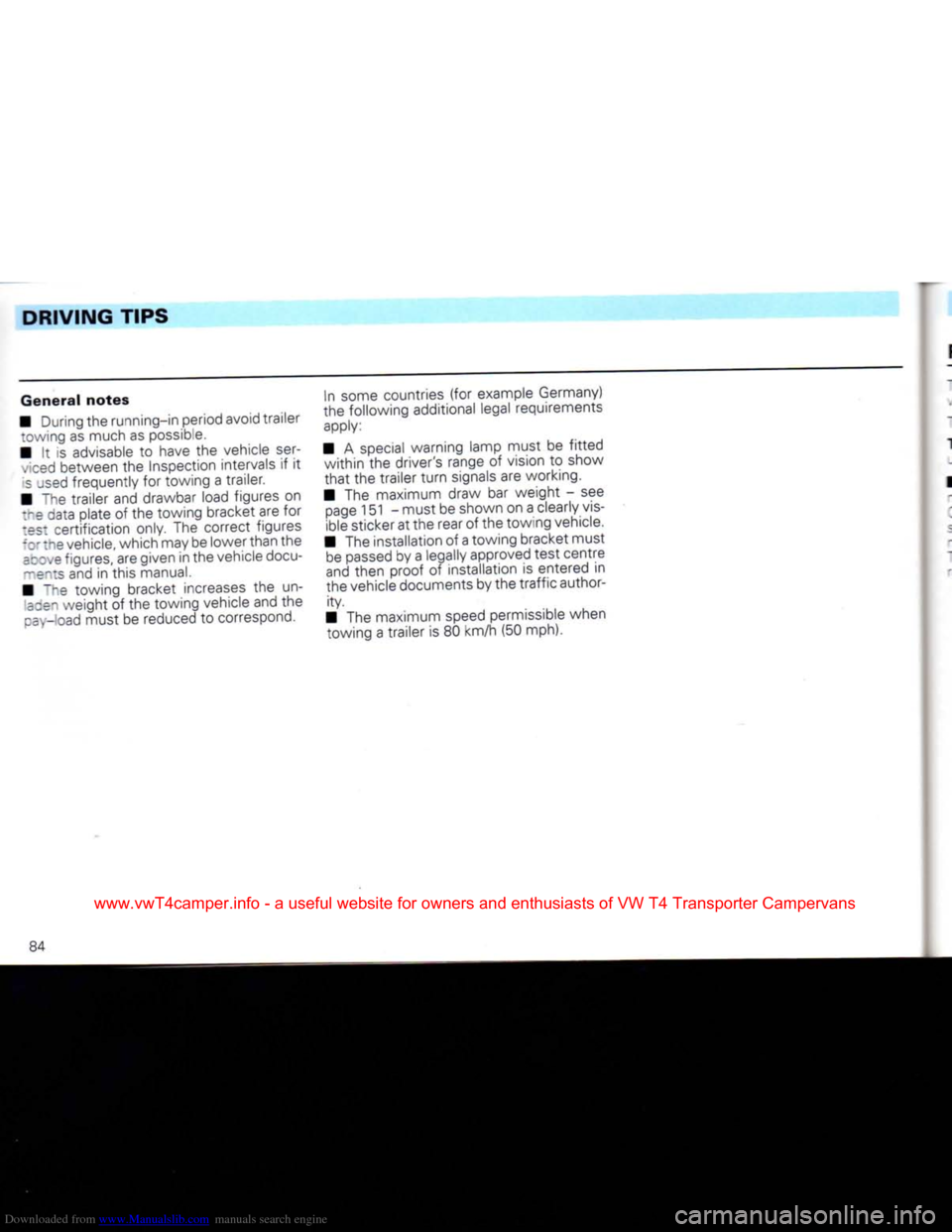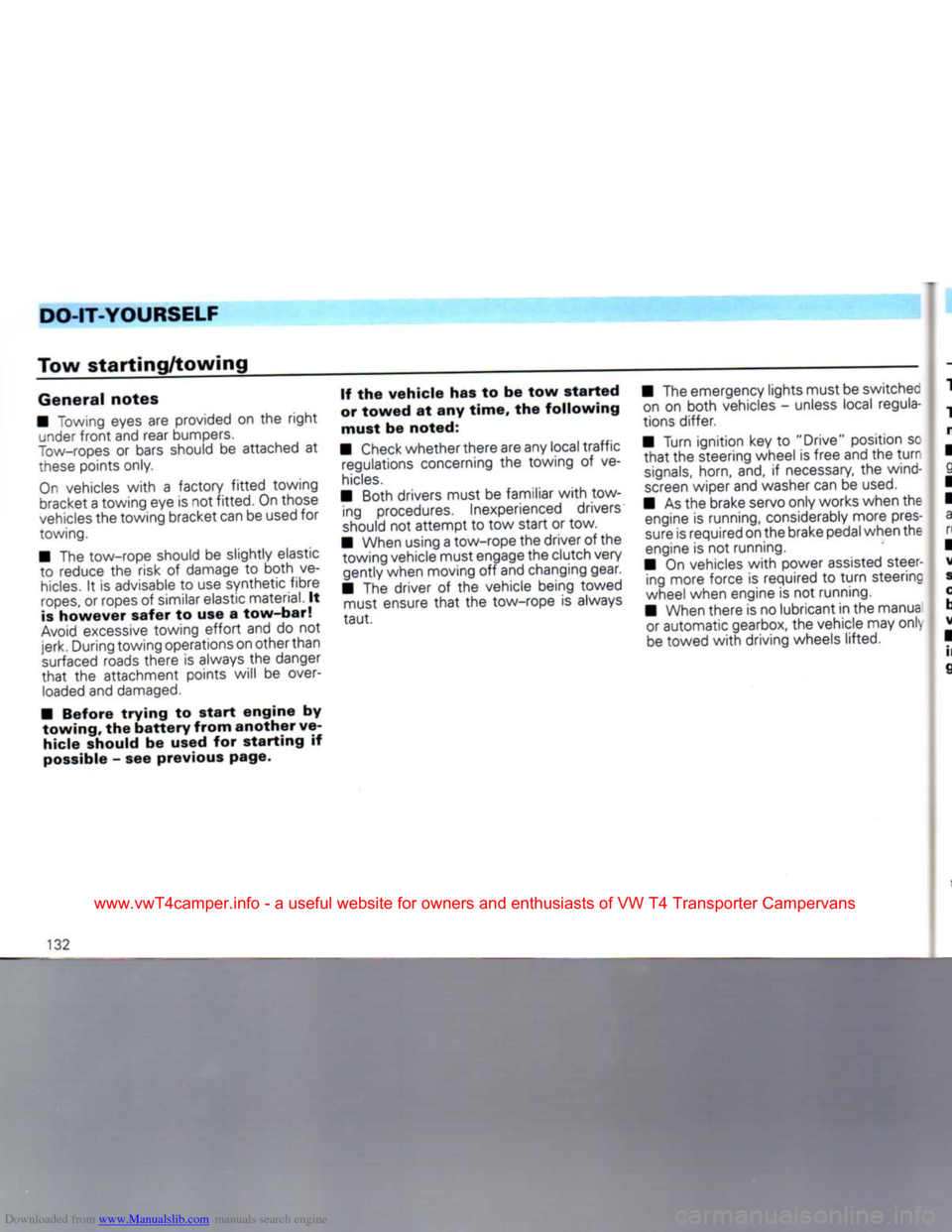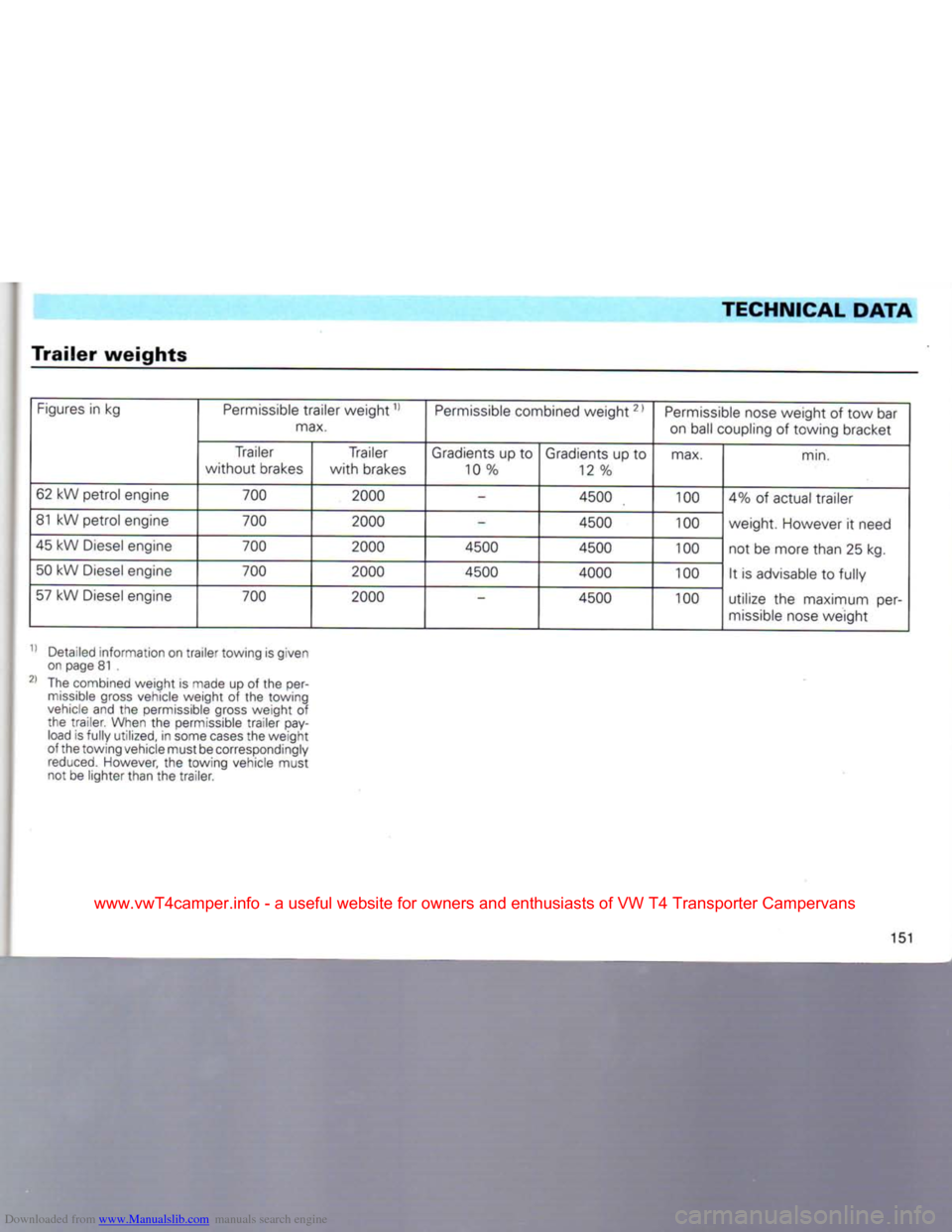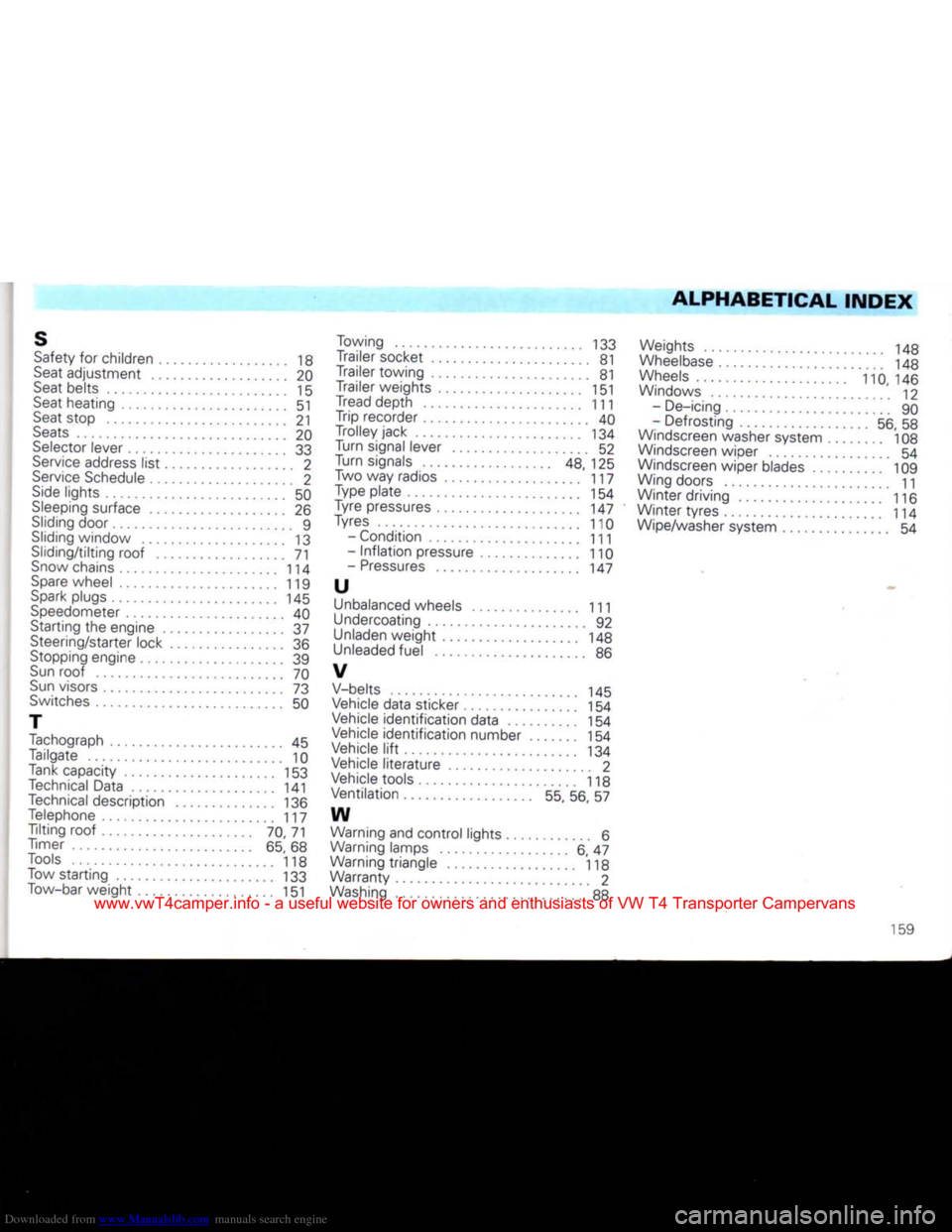1992 VOLKSWAGEN TRANSPORTER tow bar
[x] Cancel search: tow barPage 53 of 164

Downloaded from www.Manualslib.com manuals search engine
CONTROLS
AND
EQUIPMENT
3
-
Emergency lights .
nen the emergency lights are on, a warn-
'z lamp in the switch flashes as well.
Ine system also works when the ignition is
;
.-.itched off.
4
-
Knurled wheel for seat
^Jf
heating*
~~e cushion and backrest of the
front
seats
:
=
n
be heated electrically when the ignition
s
on.
_~e
heating is switched on and regulated .vth the knurled wheel.
•
switch heating off,
turn
knurled wheel to
:_e
left
to the detent position.
5
-
Heated rear window
QpJ
The
heating works only when ignition is on.
When
heater is on a lamp in the switch lights up.
As soon
as
window
is
clear,
switch element
off. The
reduced
current consumption helps
to re
duce
the
fuel
consumption
- see
also
page
80.
On
vehicles
with
electrically adjustable ex
terior mirrors the mirrors are heated as long
as
the rear window heating is switched on.
6
-
Fog lights •/
|Q
Rear fog light
First
detent - fog lights
Second
-
front
and rear fog
detent lights, or rear fog
light
only
At the second position a warning lamp in the switch comes on.
The fog lights
work
with
the side lights (ignition on), low or high beams.
The rear fog light
works only
with
the fog lights or
with
the low or high beams.
Due
to the amount of
dazzle
it
causes
the
rear
fog
light
should only be switched on
when the visibility is very poor (in Germany
for example, below 50 metres).
Note
The
electrical system of the factory
fitted
tow bar* is wired-up so
that
when towing
a
trailer
fitted
with
rear fog lights, the rear
fog
light
on the towing vehicle are automati
cally
switched off.
51
www.vwT4camper.info - a useful website for owners and enthusiasts of VW T4 Transporter Campervans
Page 85 of 164

Downloaded from www.Manualslib.com manuals search engine
DRIVING
TIPS
• Where possible make
full
use of the maximum permissible drawbar weight on
call
of the towing bracket - see page 151 -
cut do not exceed it.
• While observing the permissible trailer
and
drawbar weight, distribute the load in
the trailer so
that
heavy objects are as near
as
possible to the axle. The objects must
a
so be secured so
that
they cannot slip
aoout.
• Check the
tyre
pressures on the towing
/ehicle
and the trailer.
• The headlight settings, should be
:hecked
with
trailer attached before mov- ng off and adjusted as necessary.
On
vehicles
with
headlight beam control it
is
only necessary to
turn
the knurled disc in
:ash
in the appropriate direction.
Driving
instructions
To
obtain the best possible handling of ve
hicle
and trailer, the following should be
noted:
• Try to avoid driving
with
an unladen ve
hicle
and a loaded trailer. If this cannot be
avoided,
only drive slowly to allow for the unfavourable weight distribution.
• As driving stability of vehicle and trailer
decreases
when the speed increases do not
drive at the maximum permissible top
speed
in unfavourable road, weather or
wind conditions - particularly when going downhill. In any
case
the speed must be reduced im
mediately the trailer shows the slightest
sign
of snaking. On no account try to stop
the snaking by accelerating.
• For safety reasons one should not drive faster than 80 km/h (50 mph). This also
applies
in countries where higher speeds
are permitted. • Always brake in good time. If the trailer
has
an overrun brake, apply the brakes gen
tly at
first
then firmly. This will avoid the
jerk
ing caused by the trailer wheels locking.
Change
down before going down a steep hill so
that
the engine can act as a brake.
• When a long climb in a low gear
with
ex tremely high engine revs must be nego
tiated at exceptionally high ambient temperatures the coolant temperature gauge must be observed. When the gauge needle
moves
to the
>~zza'
e~z of :ne
scale,
the road speed must be reduced immediately. If nevertheless ~g amp flashes,
stop immediately and si ow the engine to
cool
off at idling speed for several minutes.
• The cooling effect of the radiator fan
can
not be increased by changing down, be
cause
the speec of t~e
~a~
s ~o! dependent
on the engine
speed.
One should therefore not change down even when towing a
trailer as long as :-e e-g -e zar cope with out the vehicle speed dropping too much.
83
www.vwT4camper.info - a useful website for owners and enthusiasts of VW T4 Transporter Campervans
Page 86 of 164

Downloaded from www.Manualslib.com manuals search engine
DRIVING
TIPS
General
notes
• During the running-in period avoid trailer "owing as much as possible.
• It is advisable to have the vehicle ser-
.ced
between the Inspection intervals if it
s
used frequently for towing a trailer.
• ""he trailer and drawbar load figures on
:re
data plate of the towing bracket are for
:es:
certification only. The correct figures
forthe
vehicle, which may be lower than the
acove
figures, are given in the vehicle docu-
~e~:s
and in this manual.
• The towing bracket increases the un-
535"
weight of the towing vehicle and the
pay-load
must be reduced to correspond. In some countries (for example Germany)
the following additional legal requirements
apply:
• A special warning lamp must be
fitted
within
the driver's range of vision to show
that
the trailer
turn
signals are working.
• The maximum draw bar weight - see
page
151 - must be shown on a clearly
vis
ible sticker at the rear of the towing vehicle.
• The installation of a towing bracket must
be
passed by a legally approved test centre
and
then proof of installation is entered in
the vehicle documents by the
traffic
author ity.
• The maximum speed permissible when towing a trailer is 80 km/h (50 mph).
84
www.vwT4camper.info - a useful website for owners and enthusiasts of VW T4 Transporter Campervans
Page 134 of 164

Downloaded from www.Manualslib.com manuals search engine
DO-IT-YOURSELF
Tow
starting/towing
General
notes
• "owing eyes are provided on the
right
under
front
and rear bumpers.
Tow-ropes
or bars should be attached at
these
points only.
On
vehicles
with
a factory
fitted
towing bracket a towing eye is not fitted. On those
vehicles
the towing bracket can be used for
towing.
• The tow-rope should be slightly elastic to reduce the risk of damage to both ve
hicles.
It is advisable to use synthetic fibre
ropes,
or ropes of similar elastic material. It
is
however
safer
to use a
tow-bar!
Avoid
excessive towing
effort
and do not
jerk.
During towing operations on other than
surfaced
roads there is always the danger
that
the attachment points will be over
loaded
and damaged.
•
Before
trying
to
start
engine
by
towing,
the
battery
from
another
ve
hicle
should be used for
starting
if
possible - see previous page. If the
vehicle
has to be tow
started
or
towed
at any
time,
the
following
must
be noted:
•
Check
whether there are any local traffic regulations concerning the towing of ve
hicles.
• Both drivers must be familiar
with
tow ing procedures. Inexperienced drivers
should
not attempt to tow start or tow.
• When using a tow-rope the driver of the towing vehicle must engage the clutch very gently when moving off and changing gear.
• The driver of the vehicle being towed must ensure
that
the tow-rope is always
taut.
• The emergency lights must be switchec
on on both vehicles - unless local regula
tions differ.
• Turn ignition key to "Drive" position sc
that
the steering wheel is free and the
turr
signals,
horn, and, if necessary, the wind
screen
wiper and washer can be
used.
• As the brake servo only works when the engine is running, considerably more pres
sure
is required on the brake pedal when the
engine is not running.
• On vehicles
with
power assisted steer ing more force is required to
turn
steering
wheel when engine is not running.
• When there is no lubricant in the manua or automatic gearbox, the vehicle may only
be
towed
with
driving wheels lifted.
132
www.vwT4camper.info - a useful website for owners and enthusiasts of VW T4 Transporter Campervans
Page 153 of 164

Downloaded from www.Manualslib.com manuals search engine
TECHNICAL DATA
Trailer
weights
Figures
in kg
Permissible
trailer weight11
max.
Permissible
combined weight21
Permissible
nose weight of tow bar
on ball coupling of towing bracket
Figures
in kg
Trailer
without
brakes Trailer
with
brakes
Gradients
up to
10 % 12 % max.
min.
62 kW petrol engine 700
2000 -4500
100
4%
of actual trailer
weight. However it need
not be more than 25 kg. It is advisable to fully
utilize the maximum per
missible
nose weight
81 kW petrol engine
700 2000
-4500
100
4%
of actual trailer
weight. However it need
not be more than 25 kg. It is advisable to fully
utilize the maximum per
missible
nose weight
45
kW Diesel engine
700 2000 4500 4500
100
4%
of actual trailer
weight. However it need
not be more than 25 kg. It is advisable to fully
utilize the maximum per
missible
nose weight
50 kW Diesel engine
700
2000 4500 4000 100
4%
of actual trailer
weight. However it need
not be more than 25 kg. It is advisable to fully
utilize the maximum per
missible
nose weight
57 kW Diesel engine
700 2000
4500 100
4%
of actual trailer
weight. However it need
not be more than 25 kg. It is advisable to fully
utilize the maximum per
missible
nose weight
Detailed information on trailer towing is given
on page 81 .
The combined weight is made up of the per
missible
gross vehicle weight of the towing
vehicle and the permissible gross weight of the trailer. When the permissible trailer pay-load is fully utilized, in some
cases
the weight
of the towing vehicle must be correspondingly
reduced.
However, the towing vehicle must
not be lighter than the trailer.
151
www.vwT4camper.info - a useful website for owners and enthusiasts of VW T4 Transporter Campervans
Page 161 of 164

Downloaded from www.Manualslib.com manuals search engine
ALPHABETICAL
INDEX
S
Safety
for children 18
Seat
adjustment 20
Seat
belts 15
Seat
heating 51
Seat
stop 21
Seats
20
Selector
lever 33
Service
address list 2
Service
Schedule 2
Side
lights 50
Sleeping
surface 26
Sliding
door 9
Sliding
window 13
Sliding/tilting roof "71
Snow
chains 114
Spare
wheel 119
Spark
plugs 145
Speedometer
40
Starting the engine 37
Steering/starter lock 36
Stopping engine 39
Sun
roof 70
Sun
visors 73
Switches
50
T Tachograph 45 Tailgate 10
Tank capacity 153
Technical
Data 141
Technical
description 136 Telephone 117
Tilting roof 70, 71
Timer 65, 68
Tools
118 Tow starting 133
Tow-bar weight 151 Towing 133
Trailer socket 81
Trailer towing 81
Trailer weights 151
Tread depth 111 Trip recorder 40
Trolley jack 134 Turn signal lever 52
Turn signals 48, 125
Two way radios 117
Type plate 154 Tyre pressures 147
Tyres
110 - Condition 111
-
Inflation
pressure 110 - Pressures 147
u
Unbalanced
wheels 111
Undercoating 92
Unladen
weight 148
Unleaded
fuel 86
V
V-belts
145
Vehicle
data sticker 154
Vehicle
identification data 154
Vehicle
identification number 154
Vehicle
lift
134
Vehicle
literature
2
Vehicle
tools 118
Ventilation 55, 56, 57
w
Warning and control lights 6 Warning lamps 6, 47
Warning triangle 118
Warranty 2
Washing
88 Weights 148
Wheelbase
148
Wheels
110, 146
Windows 12
- De-icing 90
- Defrosting 56, 58
Windscreen
washer system 108
Windscreen
wiper 54
Windscreen
wiper blades 109
Wing doors 11 Winter driving 116
Winter tyres 114
Wipe/washer
system 54
159
www.vwT4camper.info - a useful website for owners and enthusiasts of VW T4 Transporter Campervans